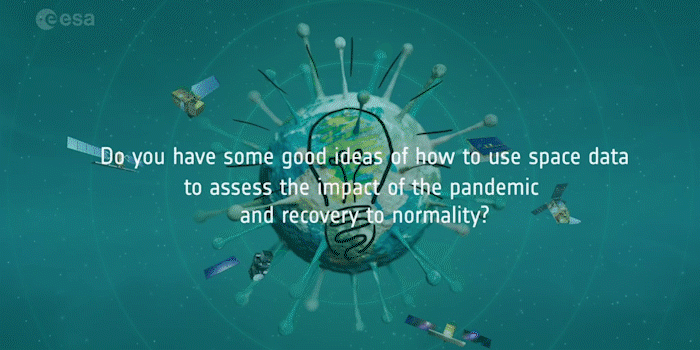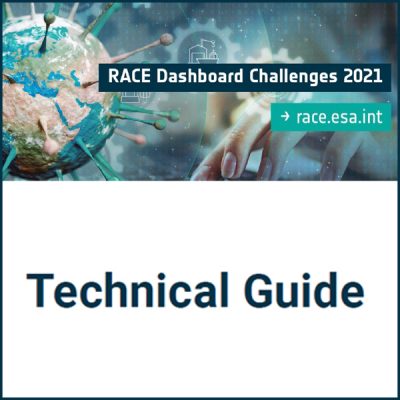Would you like to join the challenge of designing and developing an indicator of the pandemic’s impacts on society, based on the wealth of satellite Earth Observations, geospatial information and additional data sources available on the RACE dashboard and the EuroDataCube?
A new window of opportunity is going to be open starting 1 September.
For 3 months you will have access to free data, tools and support to develop and test your idea.
After challenge#1 and challenge#2 focused on single themes, challenge#3 will be more open and flexible. You’ll have the chance to address the past themes on transport and pollution and socio-economic indicators, to work on the newly proposed theme on post-pandemic recovery and also to propose more creative ideas on how to explore pandemic impact in new contexts.
Get inspired by this video:
Challenge themes
Background
The COVID19 pandemic has drastically affected various forms of transport, including individuals mobility, logistic supply changes or air traffic. As our transport systems are directly linked to environmental pollution, these pandemic driven changes in transport likely affected, for example, air- or water quality.
Objectives
Your challenge is to use Earth Observation and existing indicators or products in the RACE dashboard to better understand the effect of the pandemic on transport and related pollution.
Questions that you might want to address:
- How can the relation between transport/mobility and environmental parameters be observed from EO and other data sources?
- How have transport and environmental parameters changed over time since the start of the pandemic?
- How can EO data and products be used together with indicators for social mobility or traffic to better understand the impact of the pandemic?
The pandemic has been strongly affecting the economy and the socio-economic systems around the world. While these impacts are often not directly observable with Earth Observation, associated impacts may be visible or the use of interdisciplinary data may allow new ways of observing these processes.
Objectives
Your challenge is to demonstrate new ways of observing socio-economic processes and impacts during the pandemic using Earth Observation data and other products/indicators available in the RACE dashboard.
Questions that you might want to address:
- How can we observe certain sectors of the economy or the socio-economic system with Earth Observation data?
- How has the COVID pandemic affected social or economic patterns?
Pandemic related restrictions are eased as the share of the vaccinated population rises. Governments are making considerable investments in the context of the EU COVID recovery fund (e.g. green energy, public transport, common agricultural policy, climate change-related projects, etc.). Different industries (e.g. tourism, transport) are changing their modes or operation to become more resilient to pandemics and others shocks.
Objectives
Your challenge is to demonstrate how EO and related products can be used to observe COVID19 pandemic related recovery processes.
Questions that you might want to address:
- Which aspects of the European recovery plan can be observed with data in the RACE dashboard?
- How can related policies be observed using space-based data?
- Which relevant changes over time can you observe and how might these be related to the COVID recovery efforts?
The RACE dashboard has demonstrated several innovative ways to track the effects of the COVID19 pandemic in Europe. The dashboard has gradually evolved into an interactive environment offering access to many interdisciplinary datasets.
Objectives
Your challenge is to demonstrate new ways of measuring COVID19 pandemic related processes using EO and other datasets.
Questions that you might want to address:
- Which aspects of the pandemic have not yet been addressed in the RACE dashboard?
- Can you propose innovative concepts for new indicators?
- How can existing indicators be combined to unravel so far unobserved phenomena?
Touch base with ESA during the prototyping phase
Here is how ESA subject matter experts will support you to develop your solution throughout the 3 months:
- Feel free to get a preliminary validation of your idea by sending us (racecontest@eurodatacube.com) a single overview slide introducing your idea (self-paced, can be submitted any time)
- Need help getting started with EDC and the data? Training and Q&A sessions will be available to registered participants and announced via e-mail
- Interact with RACE Challenge winners and ESA subject matter experts at the RACE dashboard challenge Side Event at phiweek 2021.
How to participate
You may find a detailed overview of the RACE dashboard challenges 2021 and instructions on how to participate in the reference page. This explains also the evaluation criteria that we will follow during the review of your contribution.
For this first stage of the challenge, the Euro Data Cube provides you kindly with a tailored trial account, this will allow you to:
- Host and preconfigure Juypter notebooks for interactive development of your contribution to this challenge
- Access the relevant EO and non EO datasets currently in the RACE dashboard
- Access existing indicators in the RACE dashboard via the Euro Data Cube GeoDB
- Access tutorial notebooks and help articles of how to best make use of the Euro Data Cube technologies in an effective way
Sign-up for the challenge on this page. After signing-up you will receive an email from Euro Data Cube with tailored instructions.
For any query, please refer to the following e-mail addresses:
- all technical issues – racecontest@eurodatacube.com
- more general questions – eodash@esa.int
Please explore more technical details (i.e. available data resources, how to customise the dashboard view, more about the Euro Data Cube) in the full Technical Guide.
Don’t forget that
This third challenge will stay open for three months and close on 30/11/2021 at midnight CET.
By then you are expected to submit within the Euro Data Cube environment your results which should include:
- Juypter notebook with your prototype analysis, executable within Euro Data Cube. This should contain the analysis workflow and required functionality but should also provide some visualisation of derived results and some description and explanations of what you are doing in the overall workflow;
- Presentation with a summary of your results, addressing the following sections: Background, Objective, Approach, Methods, Implementation and Results;
- One page proposal for your upscaling plans: explain to us how would upscale your analysis for Stage 2 of this challenge to a European coverage and expanded time frame, to allow for continent scale impact assessment.
Please also send an email with links to the result documentation to: racecontest@eurodatacube.com


